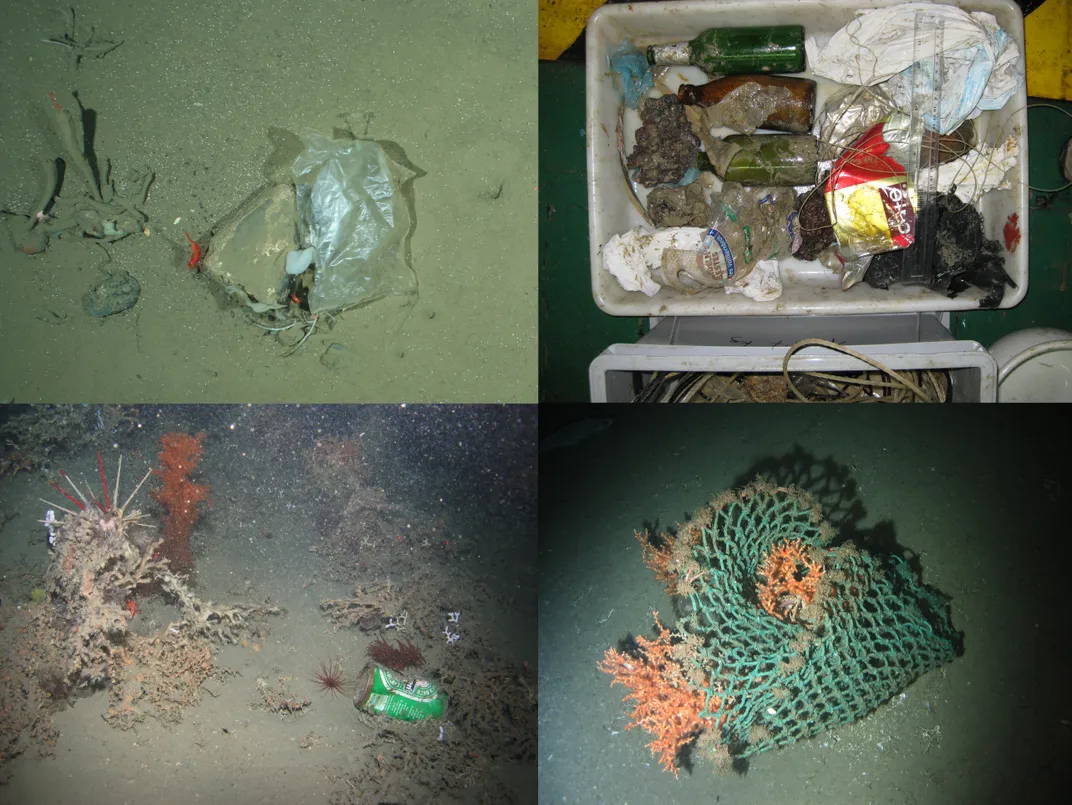Your Garbage Is Polluting Even The Deep, Remote Reaches of the Ocean
Scientists have found plastic, glass and other trash littering the seafloor and collecting in canyons
:focal(4735x1505:4736x1506)/https://tf-cmsv2-smithsonianmag-media.s3.amazonaws.com/filer/b2/e6/b2e6c1e3-2a11-4f25-b17b-dc7580b5c9d8/42-44126246.jpg)
Even creatures at the bottom of the ocean aren’t sheltered from the detritus of human civilization. Underwater surveys conducted at dozens of sites in the northeast Atlantic and Acrtic oceans and the Mediterranean Sea found fishing gear, plastic, metal, glass and other bits of garbage in shallow and deep waters both near and close to shore.
The research, led by Christopher Pham of the University of the Azores in Portugal, was published today in PLOS ONE. Similar studies have documented trash lining the seafloor in other areas, such as Monterey Canyon off California and the more than 7000-meter-deep Ryukyu trench off the coast of Japan [PDF]. Our trash is everywhere.
Around 14 billion pounds of litter makes its way into the world’s oceans every year. Some is created when fishing gear is lost. More comes when our trash washes off streets and down through waterways to the sea. Whole containers of goods may be swept overboard from the numerous ships plying the waves. And plenty of trash was deliberately dumped from barges and ships (a practice only recently banned by international convention).
The trash that floats on top of the ocean—often in great garbage patches at the center of gyres—or that washes onto beaches is most visible and gets the most attention. But plenty of it ends up on the seafloor. It’s just harder to see.
“The large quantities of litter reaching the deep ocean floor is a major issue worldwide, yet little is known about its sources, patterns of distribution, abundance and, particularly, impacts on the habitats and associated fauna,” Pham and colleagues write.
Pham’s team collected data from surveys at 32 underwater sites in the northeast Atlantic and Acrtic oceans and the Mediterranean Sea that took place between 1999 and 2011. These surveys either trawled the seafloor or sent down still and/or video cameras to image what was on the ocean bottom. The surveyed sites were located near as well as thousands of kilometers from shore, at depths of 35 to 4,500 meters, and were located on continental shelves and slopes, ocean ridges, banks, mounds and seamounts and within submarine canyons and deep basins.
Not one site was free of human garbage.
The surveys turned up trash along the mid-Atlantic ridge, 2,000 kilometers from shore. It was found in the shallowest waters as well as the deepest. Actually, the deepest areas, such as the Lisbon and Blanes canyons, had the highest densities of garbage, the researchers calculated.
“Such records were not surprising,” Pham’s team noted in their paper, “as litter is known to be present in all seas and oceans of the planet, as remote as the Southern Ocean and at depths as deep as 7,216 m in the Ryuku trench, south of Japan.”

The most common items were the ubiquitous plastic bags now banned in some cities. There were also glass bottles, fishing lines and nets, wood, cardboard, bits of clothing, pottery and a material called clinker. Clinker is the residue of burnt coal, and it was common in the late 18th to 20th centuries for steam ships to dump this waste material overboard, so most of this type of trash is more than 100 years old.
The abundance of plastic might be a surprise for some as plastic floats. But about 70 percent of it eventually sinks to the seafloor, the researchers note.
Abandoned, derelict fishing lines and nets were most often found in areas such as seamounts and banks that host dense communities of fish and shellfish. Those are the regions, of course, where fishing vessels are most likely to ply their trade.
Scientists are still figuring out the global patterns of distribution of all this garbage. But they do know quite a lot about its effects on marine life. Some organisms eat the trash, thinking its food. Others—especially turtles, marine mammals and birds—get entangled in it, and sometimes die. Fish get caught up in drifting nets, in what’s known as “ghost fishing.” And chemicals such as dioxins get consumed by small organisms and concentrated in organisms further up the food web, where these poisons can reach lethal levels.
This has to make us wonder: Is there any pristine place left on Earth?
/https://tf-cmsv2-smithsonianmag-media.s3.amazonaws.com/accounts/headshot/Sarah-Zielinski-240.jpg)
/https://tf-cmsv2-smithsonianmag-media.s3.amazonaws.com/accounts/headshot/Sarah-Zielinski-240.jpg)